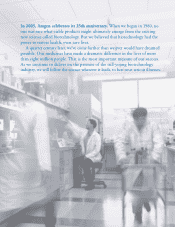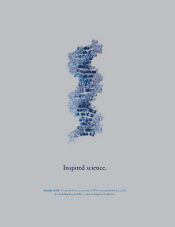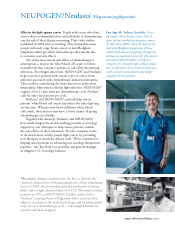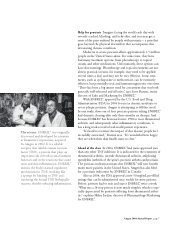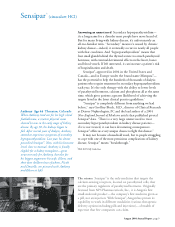Amgen 2004 Annual Report Download - page 5
Download and view the complete annual report
Please find page 5 of the 2004 Amgen annual report below. You can navigate through the pages in the report by either clicking on the pages listed below, or by using the keyword search tool below to find specific information within the annual report.
EPOGEN®(Epoetin alfa)
Chanitra Age 16 Los Angeles, California Four years ago,
when Chanitra was 12, she woke up with a swollen face and a rash
covering most of her body. Her grandmother rushed her to a local
hospital, where Chanitra was diagnosed with lupus, a chronic
infl ammatory disease that had damaged her kidneys. Chanitra
began dialysis twice a week and almost immediately began to
experience symptoms of anemia, including weight loss and fatigue.
She received EPOGEN
®
. According to her grandmother, Chanitra
now has the energy to participate in some of her favorite activities,
including “singing her heart out” in her church choir.
Going strong Sixteen years ago, anemia was not always
recognized as a serious illness. But it certainly felt like one to
people affl icted with the condition, characterized by low
numbers of vital red blood cells that deliver oxygen throughout
the body. The fatigue of severe anemia can make it impossible
to get out of bed, much less carry out daily activities. Worse,
anemia is associated with other health problems, including
cardiovascular disease, and even an increased risk of death.
Anemia is a signifi cant problem for people with chronic
kidney disease who receive dialysis. Left untreated, it can be
debilitating. In fact, many of the worst complications of chronic
kidney disease are associated with anemia. Before EPOGEN®
,
treatments for anemia were inadequate; they included potentially
dangerous blood transfusions and testosterone-based therapies
that often caused unwanted side effects.
When EPOGEN® debuted in 1989, it quickly became the
standard of care for anemia management in dialysis patients. “So
many people have experienced dramatic positive changes in their
energy and well-being, thanks to EPOGEN®
,” says Helen Torley,
vice president and general manager of Amgen’s Nephrology
business. Today, EPOGEN® is still going strong
—
and dialysis
patients and caregivers take treating anemia very seriously indeed.
The science EPOGEN® is made by introducing the DNA
sequence for human erythropoietin into a mammalian cell line.
That cell line is grown and multiplied under carefully controlled
conditions to produce a therapeutically effective form of human
erythropoietin. Injected EPOGEN® stimulates red blood cell
production in the same way as naturally occurring erythropoietin
produced by the kidneys. (For more on the science behind
EPOGEN®
, please see page 14.)
Amgen 2004 Annual Report page 3



